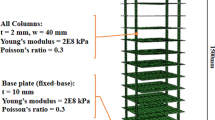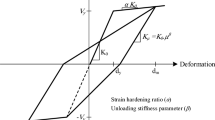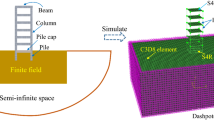Abstract
Past seismic events reveal that soil and structural responses are interdependent, not independent. The seismic behavior of irregular structures, considering soil-structure interaction (SSI) effects, significantly increases the structural vulnerability compared to traditional fixed-base structures. The study on the impact of SSI on irregular structures, especially those with floating columns, is currently limited. Hence, this study primarily examines the influence of nonlinear soil structure interactions on the dynamic response of mid-rise reinforced floating column structures resting on different soil mediums. A three-dimensional finite element programming tool is used to simulate the seismic response of structures with and without floating columns. This study explores the use of elastoplastic hinges to study the inelastic behavior of structural components. The isotropic hardening elastoplastic hysteretic soil model is used to account for the nonlinear behavior of the soil. The nonlinear time history analysis is used to perform and evaluate structural demand parameters subjected to selected ground motions. Moreover, the seismic structural response parameters, such as storey displacement, peak storey drift, peak horizontal acceleration, base shear, and member forces, are compared for both fixed and SSI bases. The analysis results show that the presence of floating columns in structures significantly alters the dynamic response of buildings compared to those without floating column structures. The incorporation of SSI effects increases the flexibility of the foundation and increases the seismic structural response of storey displacement and inter-storey drift ratio while reducing the base shear value.
















Similar content being viewed by others
References
Kramer SL (1996) Geotechnical earthquake engineering. Pearson Education India
Minimum Design Loads and Associated Criteria For Buildings and Other Structures (2016) ASCE/SEI 7, Restonted
FEMA P-1050 (2015) NEHRP recommended seismic provisions for new buildings and other structures. Washington
IS: 1893 (Part I) (2002) Indian standard criteria for earthquake resistant design of structures, fifth revision, Part-1. Bureau of Indian Standards, New Delhi
Stewart JP, Seed RB, Fenves GL (1999) Seismic soil-structure interaction in buildings. II: Empirical findings. J Geotech Geoenviron Eng 125(1):38–48
Galal K, Naimi M (2008) Effect of soil conditions on the response of reinforced concrete tall structures to near-fault earthquakes. Struct Des Tall Special Build 17(3):541–562
Veletsos AS, Meek JW (1974) Dynamic behaviour of building-foundation systems. Earthquake Eng Struct Dynam 3(2):121–138
Jennings PC, Bielak J (1973) Dynamics of building-soil interaction. Bull Seismol Soc Am 63(1):9–48. https://doi.org/10.1785/bssa0630010009
Bhattacharya K, Dutta SC, Dasgupta S (2004) Effect of soil-flexibility on dynamic behaviour of building frames on raft foundation. J Sound Vib 274(1–2):111–135
Abdel Raheem SE, Ahmed MM, Alazrak TM (2014) Soil-raft foundation-structure interaction effects on seismic performance of multi-story MRF buildings. Eng Struct Technol 6(2):43–61
Kant R, Al Agha W, Almorad WA, Thakur MS, Umamaheswari N (2022) Study on seismic performance of reinforced concrete multi-storey building considering soil-structure interaction effect. Mater Today: Proc 56:2158–2166
Scarfone R, Morigi M, Conti R (2020) Assessment of dynamic soil-structure interaction effects for tall buildings: a 3D numerical approach. Soil Dyn Earthq Eng 128:105864. https://doi.org/10.1016/j.soildyn.2019.105864
Jaber L, Temsah Y, HageChehade F, El-Mossallamy Y (2018) Effect of soil-structure interaction constitutive models on dynamic response of multi-story buildings. J Eng Sci Technol Rev 11(3):56–60
Gouasmia A, Djeghaba K (2006) Effects of nonlinear dynamic soil-structure interaction on the response of buildings. Res J Appl Sci 1(1–4):110–115
Ghandil M, Behnamfar F (2015) The near-field method for dynamic analysis of structures on soft soils including inelastic soil–structure interaction. Soil Dyn Earthq Eng 75:1–17. https://doi.org/10.1016/j.soildyn.2015.03.018
Uniform Building Code (1997) In Uniform building code. International Conference of Building Officials
FEMA: 450 (Part I) (2003) NEHRP Recommended provisions for seismic regulations for new buildings and other structures
Eurocode 8 (2005) Design of structures for earthquake resistance-part 1: general rules, seismic actions, and rules for buildings. European Committee for Standardization
Moehle JP (1984) Seismic response of vertically irregular structures. J Struct Eng (NY) 110(9):2002–2014. https://doi.org/10.1061/(asce)0733-9445(1984)110:9(2002)
Athanassiadou CJ (2008) Seismic performance of R/C plane frames irregular in elevation. Eng Struct 30(5):1250–1261. https://doi.org/10.1016/j.engstruct.2007.07.015
Ravikumar CM, Babu Narayan KS, Sujith BV, Venkat Reddy D (2012) Effect of irregular configurations on seismic vulnerability of RC buildings. Archit Res 2(3):20–26
Asadi Ghoozhdi H, Attarnejad R, Masoodi AR, Majlesi A (2022) Seismic assessment of irregular RC frames with tall ground story incorporating nonlinear soil–structure interaction. Structures 41:159–172. https://doi.org/10.1016/j.istruc.2022.05.001
Sabari S, Praveen JV (2014) Seismic analysis of multistorey building with floating column. Int J Civil Struct Eng Res 2(2):12–23
Singla S, Rahman A (2015) Effect of floating columns on seismic response of multi-storeyed RC framed buildings. Int J Eng Res Technol 4:1131–1136
Pardhi A, Shah P, Satishyadav PS, Jha AK (2016) Seismic analysis of rcc building with and without floating columns. Int J Adv Technol Eng Sci 4(3):615–621
Prasannan P, Mathew A (2017) Seismic performance of RC floating column considering different configurations. Int J Eng Res Technol 6(5):100–108
Pawar N, Dabhekar K, Patil P, Khedikar I, Jaju S (2021) Effect of floating columns on buildings subjected to seismic forces. IOP Conf Ser: Mater Sci Eng 1197(1):012018
Ibrahim A, Askar H (2021) Dynamic analysis of a multistory frame RC building with and without floating columns. Am J Civ Eng 9(6):177
Rangwala MA, Singh SK (2018) Seismic analysis of multistorey frame with and without floating columns. Int J Innov Res Sci Eng Technol 7(5):5262–5272
Nanabala SG, Ramancharla PK, Arunakanthi E (2014) Seismic analysis of a normal building and floating column building. Int J Eng Res Technol 3(9):981–987
Jagan P, Visuvasam JA (2022) Inelastic seismic behaviour of RC buildings with floating columns considering soil-structure interaction. Symp Earthq Eng Springer Nat 2:313–324
Bhosale AS, Davis R, Sarkar P (2017) Vertical irregularity of buildings: Regularity index versus seismic risk. ASCE-ASME J Risk Uncertain Eng Syst Part A: Civil Eng 3(3):04017001. https://doi.org/10.1061/ajrua6.0000900
Shashikumar NS, Gowda MR, Ashwini BT, Kumar YMV (2018) Seismic performance of braced framed structure with floating column. Int J Sci Dev Res 3(6):388–405
Kapase R, Pawar M, Deshmukh MM, Talavara SB (2017) Effect of seismic retrofitting on RC building with soft storey and floating column. Int J Eng Trends Technol 46(7):367–371
Kumbhar G, Banhatti A (2016) Seismic retrofitting of building with soft storey and floating column. Int Res J Eng Technol 3(7):1917–1921
Singh N, Kashyap V (2016) Seismic retrofitting of dormitory buildings with soft storey and floating columns. Int Res J Eng Technol 5(12):102–113
Saeed A, Najm HM, Hassan A, Qaidi S, Sabri MMS, Mashaan NS (2022) A comprehensive study on the effect of regular and staggered openings on the seismic performance of shear walls. Buildings 12(9):1293
Ozkılıc YO, Karalar M, Aksoylu C, Beskopylny AN, Stelmakh SA, Shcherban EM, Azevedo AR (2023) Shear performance of reinforced expansive concrete beams utilizing aluminium waste. J Market Res 24:5433–5448
Tayeh BA, Akeed MH, Qaidi S, Bakar BA (2022) Influence of the proportion of materials on the rheology and mechanical strength of ultrahigh-performance concrete. Case Stud Constr Mater 17:e01433
IS: 456 (2000) Plain and reinforcement concrete code of practice.Bureau of Indian Standards, New Delhi, India
IS: 875 (Part 2) (1987) Code of practice for design loads (other than earthquake) for buildings and structures–imposed loads
Roy T, Saito T, Matsagar V (2021) Multihazard framework for investigating high-rise base-isolated buildings under earthquakes and long-duration winds. Earthq Eng Struct Dynam 50(5):1334–1357
Shabani MJ, Shamsi M, Ghanbari A (2021) Seismic response of RC moment frame including topography–soil–structure interaction. Pract Period Struct Des Constr 26(4):04021046
IS: 1893 (Part I) (2016) Indian standard criteria for earthquake resistant design of structures, fifth revision, Part-1. Bureau of Indian Standards, New Delhi
Sap 2000 (Version 8) (2002) Integrated software for structural analysis and design. Computers and Structures Inc.
Kumar M, Mishra SS (2016) Study of seismic response characteristics of building frame models using shake table test and considering soil structure interaction. Asian J Civil Eng 20(3):409–419
Visuvasam J, Chandrasekaran SS (2019) Effect of soil–pile–structure interaction on seismic behaviour of RC building frames. Innov Infrastruct Solut 4(1):45
International Building Code (2008) International Code Council, USA
Uma Maheswari R, Boominathan A, Dodagoudar GR (2010) Use of surface waves in statistical correlations of shear wave velocity and penetration resistance of Chennai soils. Geotech Geol Eng 28(2):119–137. https://doi.org/10.1007/s10706-009-9285-9
Bowles J.E (1996) Foundation analysis and design, 5th edn. McGraw-Hill Education (ISE Editions)
Peck RB, Hanson WE, Thornburn TH (1974) Foundation engineering, 2nd edn, John Wiley & Sons
Schanz T, Vermeer PA, Boonnier PG (1999) The hardening soil model: formulation and verificaction, beyond 2000 in compuatational geotechnics, 1: 281–296
Plaxis BV (2022) Plaxis material models manual, The Netherlands
Hejazi Y, Dias D, Kastner R (2008) Impact of constitutive models on the numerical analysis of underground constructions. Acta Geotech 3(4):251–258. https://doi.org/10.1007/s11440-008-0056-1
Hardin BO, Drnevich VP (1972) Shear modulus and dam** in soils: Design equations and curves. J Soil Mech Found Div 98(7):667–692
Cerfontaine B, Knappett JA, Brown MJ, Bradshaw AS (2019) Effect of soil deformability on the failure mechanism of shallow plate or screw anchors in sand. Comput Geotech 109:34–45. https://doi.org/10.1016/j.compgeo.2019.01.007
Daredndeli (2001) Development of a new family of normalized modulus reduction and material dam** curves, Ph.D. Dissertation, The University of Texas at Austin, Texas
Amorosi A, Boldini D, Di Lernia A (2016) Seismic ground response at Lotung: hysteretic elasto-plastic-based 3D analyses. Soil Dyn Earthq Eng 85:44–61
Fatahi B, Huang B, Yeganeh N, Terzaghi S, Banerjee S (2020) Three-dimensional simulation of seismic slope–foundation–structure interaction for buildings near shallow slopes. Int J Geomech 20(1):04019140. https://doi.org/10.1061/(asce)gm.1943-5622.0001529
Rizzitano S, Cascone E, Biondi G (2014) Coupling of topographic and stratigraphic effects on seismic response of slopes through 2D linear and equivalent linear analyses. Soil Dyn Earthq Eng 67:66–84. https://doi.org/10.1016/j.soildyn.2014.09.003
Hashash YMA, Musgrove MI, Harmon JA (2018) Nonlinear and equivalent linear seismic site response of one-dimensional soil columns. User Manual v7. 0, Deepsoil Software 12(10)
Seed H, Wong RT, Idriss IM, Tokimatsu K (1986) Moduli and dam** factors for dynamic analyses of cohesionless soils. J Geotech Eng 112(11):1016–1032
Plaxis BV (2022) Plaxis reference manual. The Netherlands
Lysmer J, Kuhlemeyer RL (1969) Finite dynamic model for infinite media. J Eng Mech Div 95(4):859–877
Brinkgreve R, Swolfs WM, Engine E (2010) PLAXIS 2D dynamic version
Fema: 273 (1997) NEHRP guidelines for the seismic rehabilitation of buildings, Federal Emergency Management Agency
Belinchon P, Sorensen KK, Christensen R (2016) A case study of the interaction between a pile and soft soil focusing on negative skin friction using finite element analysis. In: Proc 17th Nord Geotech Meet, pp 513–522
Mat Nor AH, Yahuda AH, Pakir F (2014) Analysis of lightweight concrete “CakarAyam” foundation for road construction using Plaxis 3D foundation software. Appl Mech Mater 695:729–733. https://doi.org/10.4028/www.scientific.net/amm.695.729
Kim YS, Roesset JM (2004) Effect of nonlinear soil behavior on inelastic seismic response of a structure. Int J Geomech 4(2):104–114
Fatahi B, Tabatabaiefar SHR (2014) Fully nonlinear versus equivalent linear computation method for seismic analysis of midrise buildings on soft soils. Int J Geomech 14(4):04014016. https://doi.org/10.1061/(asce)gm.1943-5622.0000354
Kamal M, Inel M, Cayci BT (2022) Seismic behavior of mid-rise reinforced concrete adjacent buildings considering soil-structure interaction. J Build Eng 51:104296
American Society of Civil Engineers (2017) Seismic evaluation and retrofit of existing buildings. American Society of Civil Engineer
Chopra AK (1995) Dynamics of structures: theory and applications to earthquake engineering, Pearson
Pacific Earthquake Engineering Research Center (PEER) (2015) NGA-East: Median ground-motion models for the Central and Eastern North America region. PEER Report No. 2014/05
Seismosoft, Seismomatch software (2016) A Computer Program for Spectrum Matching of Earthquake Records. http://www.seismosoft.com.
Bolt BA (1973) Duration of strong ground motions. In: Fifth World Conference on Earthquake Engineering, vol 1, pp 1304–1313
El Hoseny M, Ma J, Josephine M (2022) Effect of embedded basement stories on seismic response of low-rise building frames considering SSI via small shaking table tests. Sustainability 14(3):1275
Wani FM, Vemuri J, Rajaram C (2022) Effect of soil structure interaction on the dynamic response of reinforced concrete structures. Natural Hazards Research 2(4):304–315
Standards Australia (2007) Structural design action—Earthquake actions in Australia, AS1170.4, Sydney, Australia
Akhtarpour A, Mortezaee M (2019) Dynamic response of a tall building next to deep excavation considering soil structure interaction. Asian J Civil Eng 20(4):479–502
Yeganeh N, Bazaz JB, Akhtarpour A (2015) Seismic analysis of the soil-structure interaction for a high-rise building adjacent to deep excavation. Soil Dyn Earthq Eng 79:149–170
Author information
Authors and Affiliations
Contributions
PJ: conceptualization, methodology, numerical investigation, validation, writing, and original draft preparation JAV: conceptualization, supervision, writing, reviewing, and editing. All authors have read and agreed to the published version of the manuscript.
Corresponding author
Ethics declarations
Conflict of interest
The authors declare that they have no known competing financial interests or personal relationships that could have appeared to influence the work reported in this paper.
Ethical approval
This article does not contain any studies with human participants or animals performed by any of the authors.
Informed consent
For this type of study, no informed consent is required.
Rights and permissions
Springer Nature or its licensor (e.g. a society or other partner) holds exclusive rights to this article under a publishing agreement with the author(s) or other rightsholder(s); author self-archiving of the accepted manuscript version of this article is solely governed by the terms of such publishing agreement and applicable law.
About this article
Cite this article
Jagan, P., Visuvasam, J.A. Effects of soil small strain nonlinearity on the dynamic behavior of floating column structures considering soil-structure interaction. Innov. Infrastruct. Solut. 9, 228 (2024). https://doi.org/10.1007/s41062-024-01523-4
Received:
Accepted:
Published:
DOI: https://doi.org/10.1007/s41062-024-01523-4




